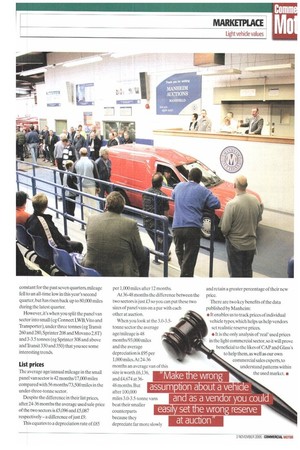Seeing the light with used values
Page 72

Page 73

If you've noticed an error in this article please click here to report it so we can fix it.
Alex Wright, commercial vehicle sales manager at Vlanheim Auctions, explains why information is power when it comes to valuing light CVs.
The light CV market enters the late autumn in good shape and, as predicted, the summer treated the market kindly, with prices and activity more consistent than in previous years.
As always there is a debate about what vehicles are worth when they come to the auction, and in the current market, with its myriad of different sectors and sub sectors, it's more difficult than ever to be certain about what a specific vehicle is worth.
During the third quarter, according to our latest Market Analysis report into the dynamics of the used light CV sector, the average selling price of used vans going through the Manheim network was £3,118; a fall of j ust £199 from the second quarter.
In previous summers this value fell considerably more, reinforcing the fact that the used van market was relatively stable throughout the summer of 2005.
Prices peaked at 13,438 in the third quarter of last year, bottoming out during the same period this year.The average age of stock is gradually reducing — over the past six months it has held steady at 49 months.
The average mileage during the third quarter in 2005 was 72,590,a fall from the previous seven-quarter high of 78,225 miles.
The more you learn about the trends affecting different parts of the used market the better the decisions you make when buying or selling vehicles. A good example is when you look at the CDV and car-van sectors in our Market Analysis report.
Various stages
From the outside the difference in vehicle types is relatively small, but the trends at various stages in the vans' fives are very different. During this year's third quarter the average age of car-vans was 68 months with average mileage at 65,000 miles, down from 73,000 in the previous quarter.lhat compares with the CDV market in the latest quarter where the average age was 47 months and the average mileage a shade over 62,000 miles.
When you look at used prices in both markets the difference between the sectors changed rapidly depending on age.
At 12-24 months an average car-van was worth 34% of its original value, compared with 43% for a CDV. However, at 48-60 months vehicles in both sectors were worth 20% of their list price new.
Make the wrong assumption about a vehicle and as a vendor you could easily set the wrong reserve at auction and either sell it too cheap or price it too high and risk the vehicle not selling on its first visit to the sale room.
The same goes for the panel van sector, the largest source of used vans in the UK.
Tracking seven quarters of used activity across the entire panel van sector, the average age of vehicles is 48 months While the average age has remained constant for the past seven quarters,mileage fell to an all-time low in this year's second quarter, but has risen back up to 80,000 miles during the latest quarter.
However, it's when you split the panel van sector into small (eg Connect LWB, Vito and Transporter), under three tonnes (eg Transit 260 and 280, Sprinter 208 and Movano 2.8T) and 3-3.5 tonnes (eg Sprinter 308 and above and Transit 330 and 350) that you see some interesting trends.
List prices The average age/annual mileage in the small panel van sector is 42 months/17,000 miles compared with 56 months/73,500 miles in the under-three-tonne sector.
Despite the difference in their list prices, after 24-36 months the average used sale price of the two sectors is £5,096 and £5,087 respectively— a difference ofjust £9.
This equates to a depreciation rate of £85 per 1,000 miles after 12 months.
At 36-48 months the difference between the two sectors is just £3 so you can put these two sizes of panel vans on a par with each other at auction.
When you look at the 3.0-3.5tonne sector the average age/mileage is 48 months/93,000 miles and the average depreciation is £95 per 1,000 miles. At 24-36 months an average van of this size is worth £6,136, and £4,674 at 3648 months. But after 100,000 miles 3.0-3.5-tonne vans beat their smaller counterparts because they depreciate far more slowly and retain a greater percentage of their new price.
There are two key benefits of the data published by Manheim: • It enables us to track prices of individual vehicle types, which helps us help vendors set realistic reserve prices.
• It is the only analysis of 'real' used prices in the light commercial sector, so it will prove beneficial to the likes of CAP and Glass's to help them, as well as our own commercial sales experts, to understand patterns within the used market. r










































































































































































































